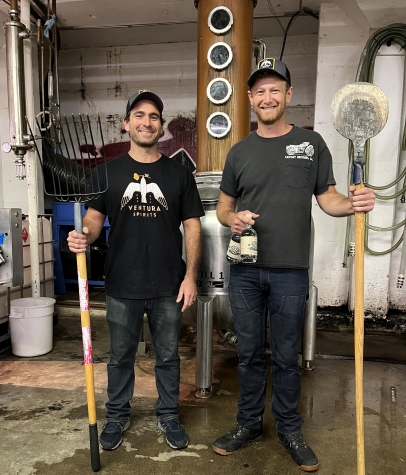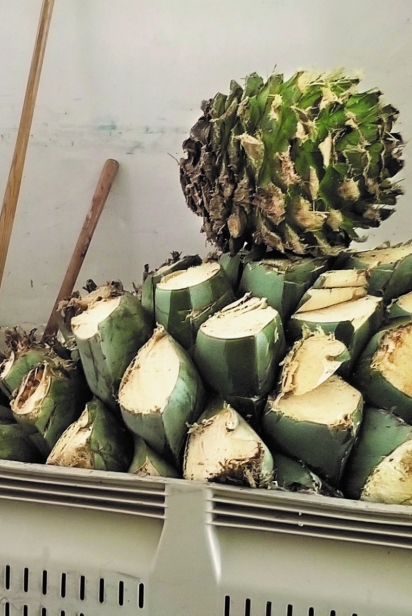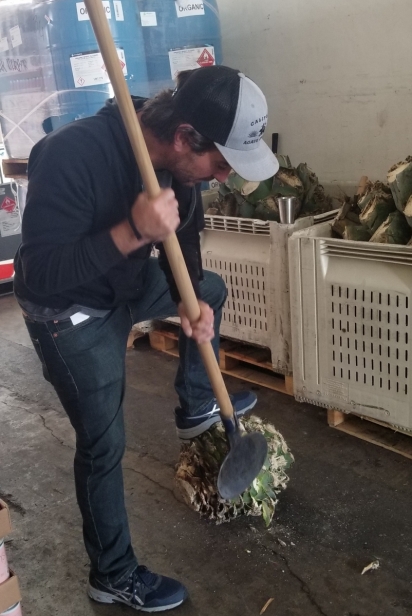Agave Spirits
Five years ago, Henry Tarmy and Andrew Caspary, two of the four co-founders of Ventura Spirits, received a phone call that pivoted their business: “Hey, our agave plants are flowering. Can you take them now?”
Doug Richardson and ranch manager John Kleinwachter were calling from La Paloma Ranch in the foothills of Santa Barbara (owned by Eric Hvolboll); Richardson was on the forefront of a nascent agave farming movement in California and had sold the ranch their agave and consulted on the planting.
The call sounded urgent because when agave plants flower, their sugar concentration is at its peak—the crucial time period to harvest the piña, or agave core, for distillation. While Ventura Spirits was unprepared to distill agave at that moment, they didn’t let this deter them in the face of a ripe opportunity for their figurative and literal entrepreneurial spirits: “Yes! We’ll take them!”
When the agave opportunity arose, Ventura Spirits was already an established distillery with a unique focus on making use of local produce. Since 2011, they have been concocting brandy from local strawberries and prickly pears, vodka from local apples and gin from local wild botanicals.
“What gets us excited is doing something that is fundamentally or inherently of this place,” explains Henry, “and hopefully at the same time actually adds value, adds something new to the great wide world of spirits rather than being derivative.”
Agave spirits not only fit into this mission, but also position Ventura Spirits on the forefront of an exciting movement at a time when drought and water restrictions are forcing farmers to let their almond, walnut, avocado and citrus land fallow.
“This is a crop that makes a lot of sense for the land here,” says Andrew.
Agave is drought-resistant and fire-resistant. Moreover, it provides a new revenue stream for farmers: “We are offering an option that didn’t exist to growers before because, at least for food/beverage use, there was no market for California growers,” continues Andrew.
And, importantly, the taste is now nationally recognized for its excellence: “Complex peppery flavor with hints of honeycomb. It’s rich in cinnamon with a sweet and creamy finish. What is this?” commented the American Spirits Council of Tasters (ASCOT) upon awarding Ventura Spirits agave spirit Yolo, the prestigious 2022 Double Platinum Award.
What’s the secret to their success? Andrew attributes it to not necessarily coming up with new ideas, or new technology, but rather understanding “the oldest ideas.” Henry elaborates, “The reason we drink what we drink is that there is always some very explicit link between where it was developed and local agriculture.” He gives examples of Caribbean rum and Midwestern whiskey, which historically developed from local surplus in sugar and wheat, respectively.
“In that historical context, we aspire to position ourselves. That popular awareness of the dynamic between agriculture and distilling has been lost as everything has become globalized. We could get our corn from Iowa, but there are opportunities where we are, and historically and practically, it just makes sense to use what is here.” Andrew adds, “Novel products require lots of education in the market, but we find that these ideas and new flavors increasingly resonate in the market.”
Their dedication to this historic ethos that reveres the region is evident in every aspect of their agave fermentation process. Henry, Andrew and co-founders Anthony Caspary and James Greenspun actually harvested more than half the agave plants themselves with their own tools.
“They have a lot of sugar at that point,” says Andrew, “but not the kind yeast can act on and turn into alcohol.”
So, after steaming the piñas, “we were literally pounding cooked agave with a four-by-four post that we had screwed handles to,” recalls Andrew.
“Which is labor intensive,” Henry says. “But if you look at mescal production, they’ve been doing that more or less since the beginning.” He adds, “We now use an electric shredder.”
Next, they roast the white, steamed piñas until they are caramelized like onions into a deep, dark brown color to unlock the flavorful sugars. Finally, they process the piñas by grinding or pressing off the juice to get as much of the sugar, or agave juice, out of the plants as possible. While this is the same fermentation process and same blue agave plant used to make traditional tequila in Mexico, what they are creating is a distinct, regional agave spirit.
“We want to produce spirits as faithful as possible to the unique character of agaves we’re harvesting,” says Henry. “What’s our point of view? What do we want to emphasize or coax out of the plant?” Given their award-winning success of Yolo, their deliberate agave distillation process, honoring the region and the agave tradition, is working.
Moving forward, the founders have impressive plans to pave the agave road, literally. Just the other day Andrew discussed using non-compostable piña fibers as an alternative cover for dirt routes. They are key members of a newly formed California Agave Council, made up of scientists, retailers, growers, distillers, and legislators, and they shared their insight as session speakers at the council’s first agave conference this year.
Importantly, this group of agave industry experts helped legally define California agave spirit as having to be made from agave in the state, “which seems obvious but it’s not. It’s actually a key distinction,” says Henry. “Before, you could buy agave spirits from Mexico and put it in a bottle and call it California Agave Spirits.” Now, “the defined category helps consumers understand what California Agave Spirits means, and that it means something.”
Additionally, Andrew and Henry say they are encouraged by the data being collected on different agave species, and what varieties grow best in our specific climate. To date, the guys have only distilled blue agave (and Agave americana, though without public release), but there’s research showing there may be agave species more suitable to California’s rapidly changing climate.
Their approach to growing their business adheres to their approach that started their business: adventurous yet thoughtful. Says Henry, “I’m excited for us to be at the beginning of what’s a new agricultural economy here in California, and think ‘How do we do this responsibly? How do we do this in a way that’s compelling? What does it look like environmentally, agriculturally, socially?’”
Ventura Spirits proves that in a challenging era for agriculture, it helps to be bold and astute, perhaps even considering old ideas to solve new problems.







